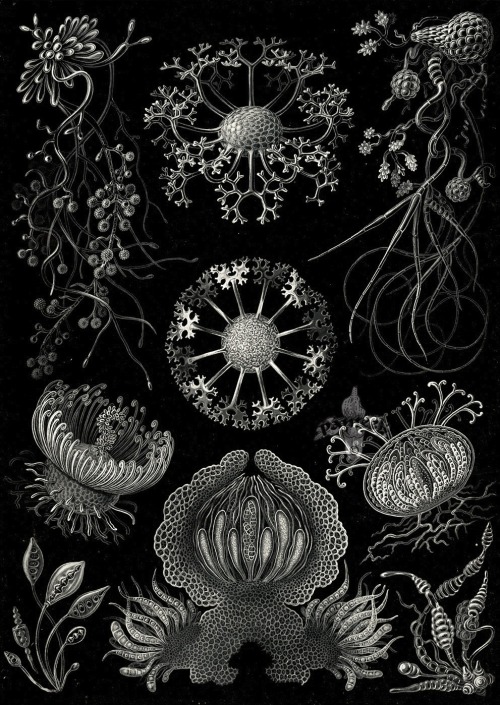Stretching SpaceTime

Stretching SpaceTime
According to general relativity, the sun’s mass makes an imprint on the fabric of spacetime that keeps the planets in orbit. A neutron star leaves a greater mark. But a black hole is so dense that it creates a pit deep enough to prevent light from escaping.
Image credit: James Provost
More Posts from Hannahhaifisch and Others



Drafts of tessellations…
Triphilia by Robin Scholz, Star/Flower, star side, by Lydia Diard.
Hannah Reber, “snowmotion”, 2013, video study









Ernst Haeckel. Hexacoralla, Ascomycetes, Lichenes, Phaeodaria, Ophiodea, Spumellaria, Basimycetes, Diatomea, Amphoridea. Kunstformen der Natur (Art Forms in Nature). 1899-1904.

La Vitrina Cloud Collection - Leandro Erlich (2011)
There are 27 straight lines on a smooth cubic surface (always; for real!)
This talk was given by Theodosios Douvropoulos at our junior colloquium.
I always enjoy myself at Theo’s talks, but he has picked up Vic’s annoying habit of giving talks that are nearly impossible to take good notes on. This talk was at least somewhat elementary, which means that I could at least follow it while being completely unsure of what to write down ;)
——
A cubic surface is a two-dimensional surface in three dimensions which is defined by a cubic polynomial. This statement has to be qualified somewhat if you want to do work with these objects, but for the purpose of listening to a talk, this is all you really need.
The amazing theorem about smooth cubic surfaces was proven by Arthur Cayley in 1849, which is that they contain 27 lines. To be clear, “line” in this context means an actual honest-to-god straight line, and by “contain” we mean that the entire line sits inside the surface, like yes all of it, infinitely far in both directions, without distorting it at all.

(source)
[ Okay, fine, you have to make some concession here: the field has to be algebraically closed and the line is supposed to be a line over that field. And $\Bbb R$ is not algebraically closed, so a ‘line’ really means a complex line, but that’s not any less amazing because it’s still an honest, straight, line. ]
This theorem is completely unreasonable for three reasons. First of all, the fact that any cubic surface contains any (entire) lines at all is kind of stunning. Second, the fact that the number of lines that it contains is finite is it’s own kind of cray. And finally, every single cubic surface has the SAME NUMBER of lines?? Yes! always; for real!
All of these miracles have justifications, and most of them are kind of technical. Theo spent a considerable amount of time talking about the second one, but after scribbling on my notes for the better part of an hour, I can’t make heads or tails of them. So instead I’m going to talk about blowups.
I mentioned blowups in the fifth post of the sequence on Schubert varieties, and I dealt with it fairly informally there, but Theo suggested a more formal but still fairly intuitive way of understanding blowups at a point. The idea is that we are trying to replace the point with a collection of points, one for each unit tangent vector at the original point. In particular, a point on any smooth surface has a blowup that looks like a line, and hence the blowup in a neighborhood of the point looks like this:

(source)
Here is another amazing fact about cubic surfaces: all of them can be realized as a plane— just an ordinary, flat (complex) 2D plane— which has been blown up at exactly six points. These points have to be “sufficiently generic”; much like in the crescent configuration situation, you need that no two points lie on the same line, and the six points do not all lie on a conic curve (a polynomial of degree 2).
In fact, it’s possible, using this description to very easily recover 21 of the 27 lines. Six of the lines come from the blowups themselves, since points blow up into lines. Another fifteen of them come from the lines between any two locations of blowup. This requires a little bit of work: you can see in the picture that the “horizontal directions” of the blowup are locally honest lines. Although most of these will become distorted near the other blowups, precisely one will not: the height corresponding to the tangent vector pointing directly at the other blowup point.
The remaining six points are can also be understood from this picture: they come from the image of the conic passing through five of the blowup points. I have not seen a convincing elementary reason why this should be true; the standard proof is via a Chow ring computation. If you know anything about Chow rings, you know that I am not about to repeat that computation right here.
This description is nice because it not only tells us how many lines there are, but also it roughly tells us how the lines intersect each other. I say “roughly” because you do have to know a little more about what’s going on with those conics a little more precisely. In particular, it is possible for three lines on a cubic surface to intersect at a single point, but this does not always happen.
I’ll conclude in the same way that Theo did, with a rushed comment about the fact that “27 lines on a cubic” is one part of a collection of relations and conjectured relations that Arnold called the trinities. Some of these trinities are more… shall we say… substantiated than others… but in any case, the whole mess is Laglandsian in scope and unlikely even to be stated rigorously, much less settled, in our lifetimes. But it makes for interesting reading and good fodder for idle speculation :)

For the first time, scientists have subjected quantum entanglement to extreme levels of acceleration, and there’s nothing fragile about this “spooky action at a distance”- it’s way more robust than we thought.
In recent experiments, entangled particles held firm even while being accelerated to 30g - 30 times Earth’s acceleration - and the results could have a big impact on our search for a unified theory of modern physics.
“These experiments shall help [us] unify the theories of quantum mechanics and relativity,” says one of the team, Rupert Ursin, from the University of Vienna, Austria.
Continue Reading.
The full rotation of the Moon as seen by NASA’s Lunar Reconnaissance Orbiter.

A new study publishing this week in the Astrophysical Journal by Gary Prézeau of NASA’s Jet Propulsion Laboratory, Pasadena, California, proposes the existence of long filaments of dark matter, or “hairs.” http://ift.tt/1NdQIKk




Adjustable Wood Lamp ‘Goldberg’
The adjustable 'Goldberg’ lamp by Atelier Akerboom is a handmade wooden lamp. By adjusting the 31 openings of the lamp you can control how much light it gives out in any direction. The lamp can be used as a hanging (pendant) lamp or as table or floor lamp. The lamp is available in different colors (see information sheet) and in two sizes (30cm or 50cm diameter).
This special design is named after Michael Goldberg (1902-1990) who described the Goldberg polyhedron – a convex polyhedron made from hexagons and pentagons – first in 1937.
https://www.etsy.com/de/listing/267492092/adjustable-lamp-goldberg?ref=shop_home_active_2
-
 flapjackoctopus07 liked this · 2 months ago
flapjackoctopus07 liked this · 2 months ago -
 odinsblog liked this · 7 months ago
odinsblog liked this · 7 months ago -
 radioactive-mayonaise liked this · 10 months ago
radioactive-mayonaise liked this · 10 months ago -
 tarot-constellation-witch reblogged this · 10 months ago
tarot-constellation-witch reblogged this · 10 months ago -
 casslaica liked this · 10 months ago
casslaica liked this · 10 months ago -
 devp3 liked this · 11 months ago
devp3 liked this · 11 months ago -
 rorydbe liked this · 11 months ago
rorydbe liked this · 11 months ago -
 wyrm2021 liked this · 1 year ago
wyrm2021 liked this · 1 year ago -
 testofeye reblogged this · 1 year ago
testofeye reblogged this · 1 year ago -
 testofeye liked this · 1 year ago
testofeye liked this · 1 year ago -
 thisworldisntrealhoney liked this · 1 year ago
thisworldisntrealhoney liked this · 1 year ago -
 ishqsuvayiditabahi liked this · 1 year ago
ishqsuvayiditabahi liked this · 1 year ago -
 spacetravelor reblogged this · 1 year ago
spacetravelor reblogged this · 1 year ago -
 itscompletlywantitlookslike liked this · 1 year ago
itscompletlywantitlookslike liked this · 1 year ago -
 kosyrev liked this · 2 years ago
kosyrev liked this · 2 years ago -
 stefanopreto liked this · 2 years ago
stefanopreto liked this · 2 years ago -
 susidark liked this · 2 years ago
susidark liked this · 2 years ago -
 priscillasmirrorball liked this · 2 years ago
priscillasmirrorball liked this · 2 years ago -
 halfmilf liked this · 2 years ago
halfmilf liked this · 2 years ago -
 sparkyairstuff liked this · 3 years ago
sparkyairstuff liked this · 3 years ago -
 biggie-dee reblogged this · 3 years ago
biggie-dee reblogged this · 3 years ago -
 biggie-dee liked this · 3 years ago
biggie-dee liked this · 3 years ago -
 optimisticglittertimetravel7 reblogged this · 3 years ago
optimisticglittertimetravel7 reblogged this · 3 years ago -
 optimisticglittertimetravel7 liked this · 3 years ago
optimisticglittertimetravel7 liked this · 3 years ago -
 petr0l reblogged this · 4 years ago
petr0l reblogged this · 4 years ago -
 dimsumdyke reblogged this · 4 years ago
dimsumdyke reblogged this · 4 years ago -
 adri25 liked this · 4 years ago
adri25 liked this · 4 years ago -
 v-m-smith reblogged this · 4 years ago
v-m-smith reblogged this · 4 years ago -
 emmanuelabcd liked this · 4 years ago
emmanuelabcd liked this · 4 years ago -
 lalolalos-blog liked this · 4 years ago
lalolalos-blog liked this · 4 years ago -
 orothodoxanswers liked this · 4 years ago
orothodoxanswers liked this · 4 years ago -
 massivellamaballoon-blog liked this · 5 years ago
massivellamaballoon-blog liked this · 5 years ago -
 cocospicy-blog liked this · 5 years ago
cocospicy-blog liked this · 5 years ago